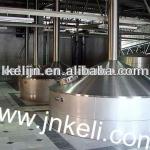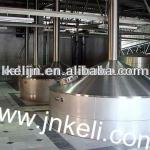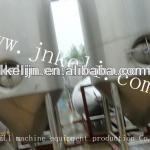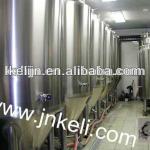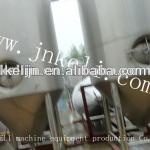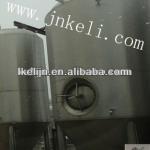Hot sale of Red copper brewery for brewpub
| Processing:Fermenting Equipment,mashing system/fermenting equipment,fermentation,fermenting equipment,fermentation | Condition:New | Place of Origin:Zhejiang China (Mainland) | Brand Name:DF |
| Model Number:DF-BR-109 | Processing Types:beer | Voltage:customzied | Power(W):1.1kw |
| Dimension(L*W*H):Can be adjusted | Weight:50- 15000 Kgs | Certification:ISO9001.CE | Warranty:3 years |
| After-sales Service Provided:Engineers available to service machinery overseas | process type:Micro brewery equipment | material:stainless steel 304 or 316L | heating method:steam heating or electrical heating |
| cooling system:ice water, refrigerator, miller board | color:coppery or silver gray | processing type:Beer or Beverage | capacity:500L-5000L |
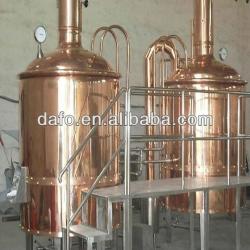
We are specialized in making many Beer fermenters,bright beer tanks,mash tuns,lauter tuns,boiling kettles...etc for beer equipment . Itadopts strictly production process,our designed and manufactured products meet both domestic and foreign customers’ demands. Our equipment with its fine workmanship, excellent performance, and convenient operation will be your best choice for brewing beer.
Our Commitment/Promise Seriously
- Reasonable price and high quality products.
- 3 years warranty.
- Free installation and personel training.
- Design and maintenance for free.
- Both inside and outside mirror polishing.
Our Products
Brewing beer equipments for hotel and bar.
Application: middle and small size drinkery,beer bar,and small size of beer factory
The Advantages
1.Dished top head
2.Mirror polishing (inner 3mm and outer 2mm)
3.Material:stainless steel 304 with low price or red copper with nice-looking
5.Configure: CIP socket,sideway manhole,strong leg supports,temperature gauge and sampling socket.All in sanitary grade.
After sale service guarantee
1.Main equipments provided with a three year warranty.
2.Equipment parts adopt sanitary components from well-known manufacturers at home and abroad, to ensure their service life.
3.After sale service,personnel received systemized training, within a 24-hour after sale service contact, to ensure that customers’ problems are solved in time.
DAFENG warmly welcome old and new friends from all around the world!
Fundamentally
The brewery processing line
beer is the product of the alcoholic fermentation by yeast of extracts of malted barley. Whilst malt and yeast contribute substantially to the character of beers, the quality of beer is at least as much a function of the water and, especially, of the hops used in its production.
Barley starch supplies most of the sugars from which the alcohol is derived in the majority of the world’s beers. Historically, this is because, unlike other cereals such as wheat, barley retains its husk on threshing and this husk traditionally formed the filter bed through which the liquid extract of sugars was separated in the brewery.
The starch in barley is enclosed in cell wall and proteins and these wrappings are stripped away in the malting process (essentially a limited germination of the barley grains), leaving the starch essentially preserved. This softens the grain and makes it more readily milled. Not only that, but unpleasant grainy and astringent characters are removed during malting.
Malting
Malting commences with steeping of barley in water at 14-18 degreesC for up to 48h, until it reaches a moisture content of 42-46%. This is usually achieved in a 3-stage process, with the steeps being interspersed with ‘air rests’ that allow the barley to get some oxygen (to ‘breathe’).
Raising the moisture content allows the grain to germinate, a process that usually takes 3-5 days at 16-20 degreeC. In germination, the enzymes break down the cell walls and some of the protein in the starchy endosperm, which is the grain’s food reserve, rendering the grain friable. Amylases are produced in germination and these are important for the mashing process in the brewery.
Progressively increasing the temperature during kilning arrests germination, and regimes with progressively increasing temperatures over the range 50 to perhaps 110degreesC are used to allow drying to <5% moisture, whilst preserving heat-sensitive enzymes. The more intense the kilning process, the darker the malt and the more roasted and burnt are its flavor characteristics.
Brewing
In the brewery, the malted grain must first be milled to produce relatively fine particles, which are for the most part starch. The particles are then intimately mixed with hot water in a process called mashing. The water must possess the right mix of salts. For example fine ales are produced from waters with high levels of calcium. Famous pilsners are from waters with low levels of calcium. Typically mashes have a thickness of three parts water to one part malt and contain a stand at around 65 degreesC, at which temperature the granules of starch are converted by gelatinization from an indigestible granular state into a “melted” form which is much more susceptible to enzymatic digestion.
The enzymes that break down the starch are called the amylases. They are developed during the malting process, but only start to act once the gelatinization of the starch has occurred in the mash tun. Some brewers will have added starch from other sources, such as maize or rice, to supplement that from malt. These other sources are called adjuncts.
After perhaps an hour of mashing, the liquid portion of the mash, known as wort, is recovered, either by straining through the residual spent grains lautering) or by filtering through plates. The wort is run to the kettle (sometimes known as the copper, even though they are nowadays fabricated from stainless steel) where it is boiled, usually for 1 hour. Boiling serves various functions, including sterilization of wort, precipitation of proteins (which would otherwise come out of solution in the finished beer and cause cloudiness), and the driving away of unpleasant grainy characters originating in the barley. Many brewers also add some adjunct sugars at this stage, at which most brewers introduce at least a proportion of their hops.
The hops have two principal components: resins and essential oils. The resins (so-called alpha-acids) are changed (“isomerized”) during boiling to yield iso-alpha-acids, which provide the bitterness to beer. This process is rather inefficient. Nowadays, hops are often extracted with liquefied carbon dioxide and the extract is either added to the kettle or extensively isomerized outside the brewery for addition to the finished beer (thereby avoiding losses due to the bitter substances’ tendency to stick on to yeast).
The oils are responsible for the “hoppy nose” on beer. They are very volatile and if the hops are all added at the start of the boil then all of the aroma will be blown up the chimney. In traditional lager brewing a proportion of the hops are held back and only added towards the end of boiling, which allows the oils to remain in the wort. For obvious reasons, this process is called late hopping. In traditional ale production, a handful of hops is added to the cask at the end of the process, enabling a complex mixture of oils to give a distinctive character to such products. This is called dry hopping. Liquid carbon dioxide can be used to extract oils as well as resins and these extracts can also be added late in the process to make modifications to beer flavor.
After the precipitate produced during boiling has been removed, the hopped wort is cooled and pitched with yeast. There are many strains of brewing yeast (Saccharomyces cerevisiae),and brewers jealously guard and look after their own strains because of their importance in determining brand identity.
Fermentation
In traditional lager brewing the 'green beer' is matured by several weeks of cold storage, prior to filtering.
Nowadays,the majority of beers, both ales and lagers, receive a relatively short conditioning period after fermentation and before filtration.This conditioning is ideally performed at -1°C for a minimum of three days, under whichconditions more proteins drop out of solution, making the beer less likely to go cloudy in the package or glass.
The filtered beer is adjusted to the required carbonation before packaging into cans, kegs or glass or plastic bottles.
picutures gallary-
7BBl SHORT FERMENTERS
15BBL PUB FERMENT
welcome for your inquiry!

| Packaging Detail:Wooden case packing |
| Delivery Detail:30days |



